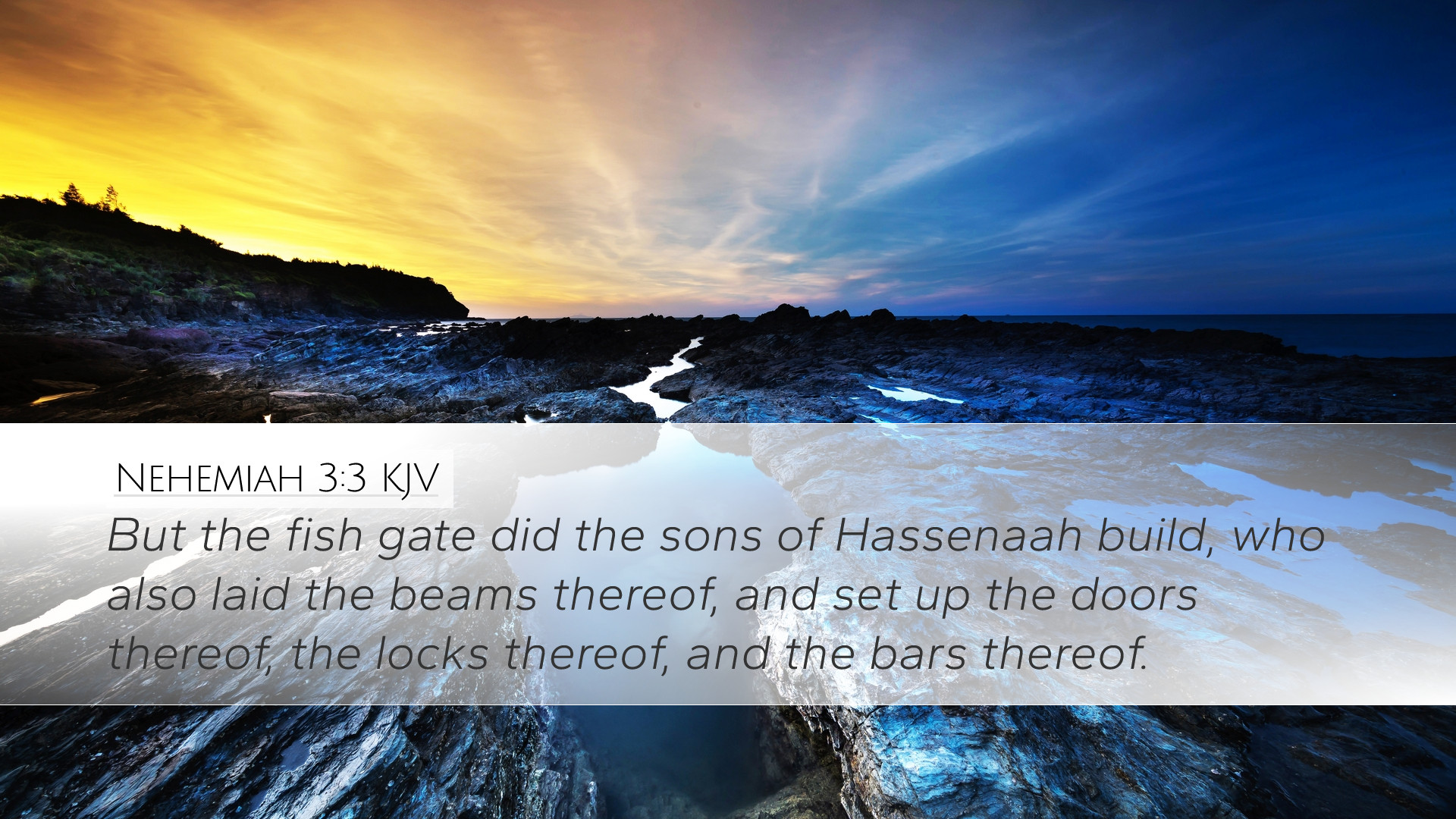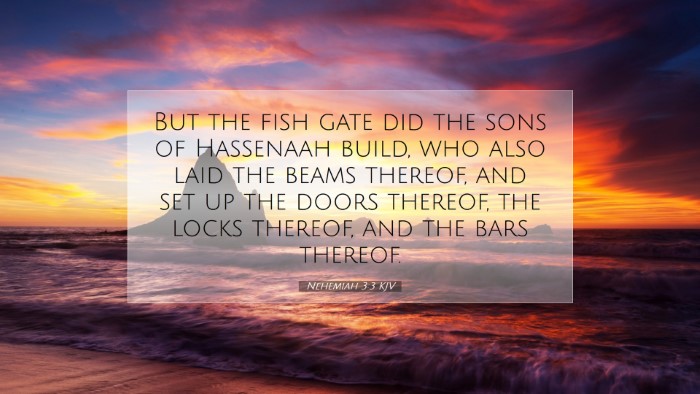Commentary on Nehemiah 3:3
Nehemiah 3:3 states:
"But the fish gate did the sons of Hassenaah build, who also laid the beams thereof, and set up the doors thereof, the locks thereof, and the bars thereof."
Introduction
This verse provides a glimpse into the communal efforts of rebuilding Jerusalem’s walls, particularly focusing on the Fish Gate. The verse not only denotes the physical construction but also symbolizes the restoration of the city and the people’s relationship with God.
Contextual Background
The book of Nehemiah details the efforts of Nehemiah, a Jewish leader serving in a Persian court, as he returns to Jerusalem to rebuild its walls. The challenges faced by Nehemiah and his people are numerous, but his leadership and divine inspiration culminate in a remarkable communal effort. This is depicted through the contributions of various families, showcasing unity and collaboration.
Significance of the Fish Gate
Symbolism: The Fish Gate is emblematic of the city's commerce and culture. It was a vital entry point for fishermen and traders, indicating the economic life of Jerusalem.
- Economic: The gate facilitated trade, highlighting the importance of commerce to the welfare of the community.
- Cultural: As a gathering point for fishermen, it embodies the everyday lives of the citizens.
- Religious: The gate's restoration reflects a return to God's favor upon the city.
Insights from Public Domain Commentaries
Matthew Henry's Commentary
Matthew Henry emphasizes that the building of the Fish Gate by the sons of Hassenaah demonstrates the importance of family involvement in communal activities. Each family or group had a role, showing the unity amongst different clans and their commitment to the city’s restoration.
Furthermore, Henry notes that this participation reflects a spiritual rebuilding as much as a physical one. He underlines the significance of the work being done with order and diligence, suggesting that this should also reflect in our spiritual lives—through diligence in faith and cooperation within the community.
Albert Barnes' Notes on the Whole Bible
Albert Barnes elaborates on the construction efforts, pointing to the meticulous attention given to details such as beams, doors, locks, and bars. Barnes highlights that every element signifies the care put into ensuring both the safety and integrity of the city.
He also mentions the strategic placement of gates, like the Fish Gate, which were crucial for defense and commerce. This strategic foresight can be likened to spiritual preparedness in the lives of believers, allowing them to be equipped to handle various challenges.
Adam Clarke's Commentary
Adam Clarke provides insight into the historical context of the Fish Gate. He explains that it was likely named for its proximity to the fish markets, emphasizing the economic and social infrastructure present in Jerusalem at the time.
Clarke remarks on the cooperation between tribes and families in the rebuilding efforts as a hallmark of Nehemiah's leadership. He encourages the reader to consider the lessons of teamwork and the mobilization of resources for a common goal—not just in rebuilding a city but in the broader sense of church and community building.
Application for Modern Readers
This commentary can be applied in various ways for pastors, students, theologians, and Bible scholars:
- Community Involvement: As seen in Nehemiah's account, community efforts are vital for achieving common goals. It inspires congregations to mobilize resources and talents for revitalization projects.
- Spiritual Renewal: The physical rebuilding of Jerusalem's walls serves as a call for spiritual renewal. Today, believers are encouraged to restore their spiritual lives as they engage in service and community outreach.
- Leadership Lessons: Nehemiah’s leadership exemplifies how effective guidance can lead to successful community projects, encouraging leaders to inspire unity and purpose within their congregations.
Conclusion
Nehemiah 3:3 serves as a powerful reminder of the importance of community, teamwork, and purposeful leadership in both the physical and spiritual realms. As modern believers reflect on this verse, they are called to participate actively in the restoration and building of their communities, echoing the commitment and diligence exemplified by the sons of Hassenaah.


